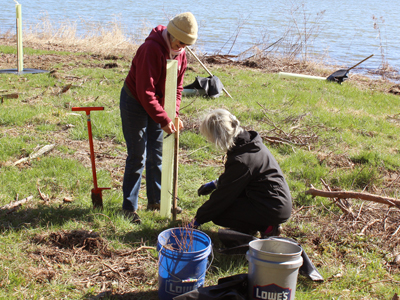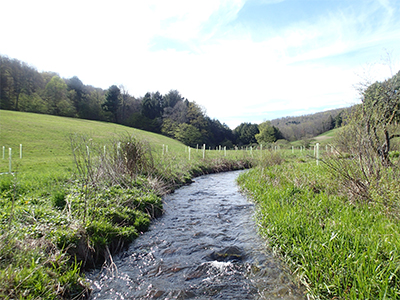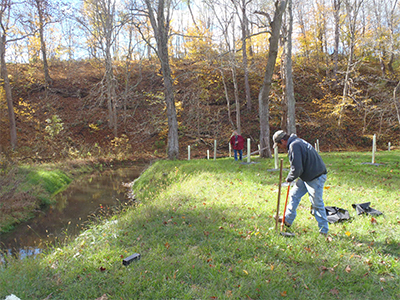Trees
Riparian Tree Plantings
There are so many benefits to planting trees, and the more trees our communities have, the better. Since 2001, WPC staff, with the help of partners and volunteers, have planted approximately 105,000 trees in rural and urban cities and towns across the region. Trees provide a vital ecological service. This is equally true when trees are planted in vegetated areas alongside streams, rivers and other waterways. These areas are called riparian zones or buffers. Native trees, non-invasive trees and other vegetation planted in these areas play a key role in filtering pollutants and improving water quality. With the help of partners and volunteers, our watershed conservation team has helped restore rivers and streams by planting more than 66,000 riparian trees along waterways since 2001.
Riparian buffers filter pollutants before they enter waterways, help to stabilize eroding streambanks, and provide many other benefits to aquatic ecosystems. These water pollutants most often come from stormwater runoff from roads, roofs and parking lots, or runoff from over-fertilized lawns, pesticides, herbicides, over-grazed pastures and livestock waste, to name a few.
Tree plantings in riparian areas make a direct impact on reducing nitrogen and sediment levels in our rivers, creeks and streams. Trees increase the infiltration capacity of soils. As a result, trees slow the flow of surface water, absorb water into the ground, filter sediment and allow any remaining sediment to settle. The cleaner our region’s waterways are, the cleaner our drinking water sources become, too.
Trees are also effective in absorbing excess nitrogen from waterways. A study of 16 streams in Eastern Pennsylvania found 200-800 times more nitrogen reached streams in non-forested areas than those in forested areas.
Our watershed conservation staff regularly undertakes riparian restoration projects. Read more about other watershed restoration and conservation methods or volunteer for an upcoming planting.
Alysha Trexler, a watershed project manager at the Conservancy, has nearly two decades of experience with water quality monitoring and watershed management. She leads riparian tree planting projects across the region, especially in rural areas in forests, parks and on farms. Riparian buffers can include crop fields, active or old pasture land, mowed open land that is privately or publicly owned. If you’re looking to plant a riparian buffer to protect the stream on your property, consider these native trees and shrubs, in addition to the soil conditions and the location from the waterway.
Trees
- Silver Maple
- Swamp White Oak
- Sycamore
- Black Willow
Shrubs
- Red Chokeberry
- Winterberry Holly
- Elderberry
- Buttonbush
Trees
- Red Maple
- Redbud
- Shagbark Hickory
Shrubs
- Spice Bush
- Shadblow Serviceberry
- Maple-leaf Viburnum
Trees
- White Pine
- Sassafras
- Red Oak
Shrubs
- Witch hazel
- Nannyberry Viburnum
Brian Crooks, a community forester and the TreeVitalize Pittsburgh GIS coordinator at the Conservancy, is a professional certified arborist who leads the care, assessment and maintenance of thousands of Conservancy-planted trees across the region. In his tree-selection process for urban riparian buffers, he looks for trees that can live and thrive in highly disturbed areas, like city landscapes. As a professionally recognized best management practice for urban plantings, he considers tree size and chooses between native and non-invasive species that can best tolerate our region's climate and conditions.
- Baldcypress
- Basswood
- Shagbark hickory
- Hornbeam
- Pawpaw
- Witch hazel
- Serviceberry
- Hawthorn
- Redbud
Trees and shrubs
- Serviceberry
- Sweetbay magnolia
- Buckeye
Pollinator plants
- Coneflower
- Lobelia spp.
- Allium spp.
Grasses
- Pennisetum spp.
- Pannicum spp.
- Learn more about our community forestry work with community members and partners.
- Learn more about riparian tree plantings through our watershed conservation program.
- Volunteer to plant trees and shrubs to protect waterways across our region.
- Benefits of Trees
- Learn more about riparian and urban tree care.
For More Information:
Watershed Conservation Program
Western Pennsylvania Conservancy
1067 Philadelphia Street, Suite 101
Indiana, PA 15701
724-471-7202
info@paconserve.org
Community Greening Program
Western Pennsylvania Conservancy
800 Waterfront Drive
Pittsburgh, PA 15222



